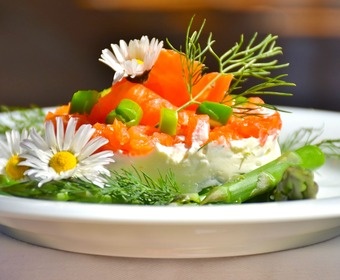
Serving fish like a pro
- Don’t make fish wait
- Don’t leave any cooking liquid on the plate
- Warm/chill the plate
- Think color, shape and consistency
- Make things easy for shellfish eaters
A perfectly cooked piece of fish deserves perfect presentation. There’s a lot of variety, some species of fish, pieces of fish and shellfish are small works of art in their own right. Others have a greater need for an appetizing setting. Here are a few tips:
Not straight to the plate
Always put a piece of boiled, steamed or poached fish on a cloth or piece of kitchen towel before putting it on the plate. If you don’t, excess liquid from the water bath will run out on the plate and dilute the sauce or make the garnish go soggy.
Don’t stack coated fish
Fried, coated pieces of fish shouldn’t be put on top of each other. It will make the pretty, tasty surface go damp and fall apart.
Warm plate, cold plate
A piece of fish weighing 150g with a temperature of about 50°C doesn’t stand a chance against half a kilo of icy cold china. Use warm plates.
Small, delicious pieces of chilled fish or shellfish quickly lose freshness on a china plate warm from the dishwasher. Use warm plates and cold plates for the right things.
Keep it simple
With the day’s catch on the plate, you only need to do a minimum to create a culinary experience. Serve a simple meal in which every component has something to contribute. Unleash your imagination and your skills, but don't let your focus stray from the ingredients.
“Simple accompaniments.”
Nina Arvidsson on the art of serving fish
More garnish
Being on top of the right garnishes (see Choosing) is a big step towards more variety and tastier fish on your dinner table. Build a repertoire that includes lemon, browned butter, parsley, chives, dill, eggs, prawns, asparagus, horseradish, spinach, mushrooms, bacon, air-dried ham, capers, beetroot, tomato, garlic, tapenade....
Think color and consistency
A dish based on fish can easily turn into a rather pallid experience on the plate. Work with garnishes that add color. Work with textures that interact with the mild flavor and flaky consistency of the fish. Crunchy vegetables or a little crisp-fried bacon. Green herbs, yellow onion, red tomatoes, attractive shellfish, etc. But avoid ingredients that don’t contribute to the whole.
Think sauce
In a fish dish, the sauce often brings the other ingredients together. It adds fat, umami, sourness, salt and sweetness where the other ingredients are often more timid in flavor. When you think fish, think sauce.
Think again
Do something new with something old. Serve fish with half a lemon, fried or grilled, cut side down. This is more than a “variation”, cooking the lemon creates new, exciting flavors. Think the same way about other accompaniments. Oven-bake the tomatoes, fry or pickle the vegetables, season and color the mayonnaise, for example.
Help with shellfish
In theory it’s fun to sit round with friends shelling shellfish together but in practice, squirting shellfish juices over yourself and your neighbors is rarely a great idea. Give your guests a bit of help. Open, or at least crack the shell, especially on larger, tougher shellfish before serving.
Add some acidity to shellfish
Use sour flavors to balance the strong flavors of shellfish. Set out lemon, a sour mayonnaise-based sauce and sharp, crystal white wines so that each guest can create their own balance.
For grilled fish
Around the Mediterranean they appreciate fresh fish so much that they prefer just to grill it and eat it as it comes, with a little salt. Besides chilled white wine and fresh bread, there are a few classic sauces that also go well with this type of experience. They taste great and they’re attractive to look at too. Learn these:
• Aioli
• Rouille
• Red “salsa”
• Tapenade
Better your guests wait for the fish than the other way round!


